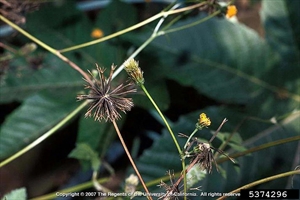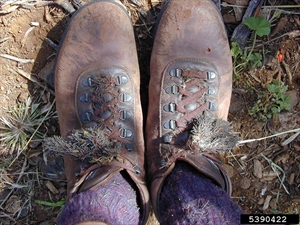- Widespread. Asia, Africa, North, South and Central America, Caribbean, Europe, Oceania. In most Pacific islands.
- Annual weed of crops, plantations, forests, pastures, waterways, gardens, parks, roadsides, waste lands, coastal and other disturbed sites. Produces large amounts viable, long-lasting, easily-dispersed seed, grows in range of habitats, developing dense populations, out-competing crop plants and native species. Alternative host for viruses (Tomato spotted wilt virus), nematodes (Meloidogyne, Rotylenchus and leaf miners (Liriomyza).
- Slender, erect, branching, up to 90 cm tall. Stems, square, hairless, green to purple. Leaves, opposite along stems, toothed margins, single at base, compound above (three leaflets). Flowerheads in clusters at end of branches, 7-8 mm across, yellow flowers in centre. Some with surrounding white petals-like structures. Fruits black, flattened with hooked bristles. Strong tap root.
- Spread: seed; clothing; water; contaminant of rice seed; vehicles.
- Biosecurity: high risk of introduction; contaminant of seed, clothing. One of the worst weeds in New Caledonia and Guam. On Global Invasive Species Database of alien invasive species (IUCN, 2020).
- Biocontrol: little known.
- Cultural control: hand weed, hoe or cultivate mechanically between rows; shade by intercropping; vehicle hygiene.
- Chemical control: in Australia: diuron; glyphosate (and Fiji); bentazone; metribuzin; 2,4-D; glufosinate-ammonium; pendimethalin; dicamba; fluroxypyr.
Pacific Pests, Pathogens and Weeds - Online edition
Pacific Pests, Pathogens, Weeds & Pesticides
Cobbler's pegs (467)
Cobbler's pegs; it is also known as beggar's ticks, or pitchforks. The name beggar's ticks is usually given to a related species, Bidens alba.
Bidens pilosa. There are other closely related species, Bidens alba and Bidens odorata. Identification is complicated because of the similarity of other species; it should be done by specialists. These species are members of the Asteraceae.
AUTHORS Grahame Jackson & Aradhana Deesh
Adapted from Cobbler's pegs (Bidens pilosa) (2018) Weeds of SE Qld and Northern NSW. Lucidcentral. (https://www.lucidcentral.org/editors-pick-animal-and-plant-identification-keys/key-to-weeds-of-se-qld-and-northern-nsw/); and additional information from CABI (2019) Bidens pilosa (bitter vine). Invasive Species Compendium. (https://www.cabi.org/isc/datasheet/9148); and Waterhouse DF, Norris KR (1987) Bidens pilosa Linnaeus. Biological Control Pacific Prospects. Inkata Press, Melbourne; Bidens pilosa (2010) Wikipedia. (https://en.wikipedia.org/wiki/Bidens_pilosa). Photos 1&3 Joseph M. DiTomaso, University of California - Davis, Bugwood.org. Photo 2 William M. Ciesla, Forest Health Management International, Bugwood.org. Photo 4 Forest & Kim Starr, Forrest Environmental, bugwood.org.
Produced with support from the Australian Centre for International Agricultural Research under project HORT/2016/185: Responding to emerging pest and disease threats to horticulture in the Pacific islands, implemented by the University of Queensland, in association with the Pacific Community and Koronivia Research Station, Ministry of Agriculture, Fiji.







